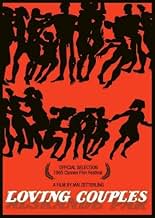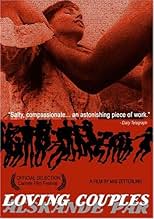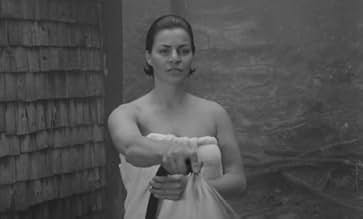अपनी भाषा में प्लॉट जोड़ेंThree expectant mothers think back over their sex lives.Three expectant mothers think back over their sex lives.Three expectant mothers think back over their sex lives.
- निर्देशक
- लेखक
- स्टार
- पुरस्कार
- कुल 1 नामांकन
Jan-Erik Lindqvist
- Peter von Pahlen
- (as Jan-Eric Lindquist)
फ़ीचर्ड समीक्षाएं
Comparisons to Bergman are inevitable as there are many similarities - the themes (resembling those in Brink of Life and Smiles of a Summer Night), cast (Harriet Andersson, Gunnar Björnstrand, and Eva Dahlbeck), and even cinematographer (the immortal Sven Nykvist). However, Mai Zetterling makes this film her own, showing a distinctly female point of view in this story of three women about to give birth at a hospital. We see misogyny in the various patriarchal figures, one of whom is a pedophile, but we see that even in a male-dominated world, women are empowered in their sexuality. This includes lesbian attraction, romps in the woods, becoming pregnant out of wedlock, and marrying a gay man to conceal the true father. It's pretty daring stuff for 1964. The real theme seems to be to show "loving couples" as they actually are, and how the world works behind a veneer of respectability.
The film is extremely strong in its first half with some gorgeous scenes outdoors, including a flashback to a funeral in a stunning birch forest, and a walk through flowering orchards at a girl's boarding school. They provide quite a contrast to the scenes in the hospital, with those squeaky gurney wheels rattling down halls that "look like prison" as a doctor puts it, and images looking up from the patient's perspective. Through flashbacks we gradually come to understand the three women's stories, and how their lives intersect, but unfortunately the plot unravels a bit as it plays out, getting messy and harder to follow than it should have been. It's a very good film, one with lots of beautiful moments and one I enjoyed, but could have been even better with stronger storytelling.
The film is extremely strong in its first half with some gorgeous scenes outdoors, including a flashback to a funeral in a stunning birch forest, and a walk through flowering orchards at a girl's boarding school. They provide quite a contrast to the scenes in the hospital, with those squeaky gurney wheels rattling down halls that "look like prison" as a doctor puts it, and images looking up from the patient's perspective. Through flashbacks we gradually come to understand the three women's stories, and how their lives intersect, but unfortunately the plot unravels a bit as it plays out, getting messy and harder to follow than it should have been. It's a very good film, one with lots of beautiful moments and one I enjoyed, but could have been even better with stronger storytelling.
Both in the ambiance and in its women's themes in this movie you can see unequivocally Bergman's influences. In particular It recalls Bergman's SECRETS OF WOMEN (1952)for the cast ( It's almost the same!)and for its episodic structure. The psychological search on women universe is another important link.
Anyway, although Mai Zetterling had abused it in her movies, I think that the flashback use is very interesting in this movie. It becomes, with the editing help, a concrete tragic matter and not only a way to tell the story. I give it a 6.
Anyway, although Mai Zetterling had abused it in her movies, I think that the flashback use is very interesting in this movie. It becomes, with the editing help, a concrete tragic matter and not only a way to tell the story. I give it a 6.
Three women at a lying-in hospital reflect on how they got there in Mai Zetterling's first feature as a director.
I was surprised at how Bergmanesque this movie was, although not as overtly cerebral. Of course a good deal of that can be attributed to the presence of Harriet Anderson, one of Bergman's frequent leading ladies, and Sven Nyquist being the cinematographer; but while it looks like a duck and walks like a duck, it doesn't quack like a duck. Instead of Bergman's meditation on keeping society going in a G*dless universe, it considers woman's place in a society run for the benefit and pleasure of its men; and the continuation of society depends more on popping out babies, a process which the women don't have on their minds when they get pregnant. Bergman may mourn the absence of G*d, but to Zetterling, He's irrelevant.
I was surprised at how Bergmanesque this movie was, although not as overtly cerebral. Of course a good deal of that can be attributed to the presence of Harriet Anderson, one of Bergman's frequent leading ladies, and Sven Nyquist being the cinematographer; but while it looks like a duck and walks like a duck, it doesn't quack like a duck. Instead of Bergman's meditation on keeping society going in a G*dless universe, it considers woman's place in a society run for the benefit and pleasure of its men; and the continuation of society depends more on popping out babies, a process which the women don't have on their minds when they get pregnant. Bergman may mourn the absence of G*d, but to Zetterling, He's irrelevant.
The story of three women from different, but related, backgrounds about to give birth in a hospital in Sweden around the start of World War I.
Via inter-cut flashbacks we are shown how they ended up in their situation.
Often beautiful Sven Nykvist photo and many great directorial flourishes from director Mai Zetterling makes this a treat.
The parallels with Bergman are many. For instance, apart from Mr. Nykvist, many of the actors have appeared in various Bergman productions, the themes dealt with here are very similar to various Bergman films, and so on. Dissimilar enough to be interesting though.
Has some very interesting scenes that I would imagine were very controversial at the time, such as two gay men frolicking and getting mock-married in a church, a graphic shot of a baby's birth, some female nudity, a lesbian kiss, etc..
Via inter-cut flashbacks we are shown how they ended up in their situation.
Often beautiful Sven Nykvist photo and many great directorial flourishes from director Mai Zetterling makes this a treat.
The parallels with Bergman are many. For instance, apart from Mr. Nykvist, many of the actors have appeared in various Bergman productions, the themes dealt with here are very similar to various Bergman films, and so on. Dissimilar enough to be interesting though.
Has some very interesting scenes that I would imagine were very controversial at the time, such as two gay men frolicking and getting mock-married in a church, a graphic shot of a baby's birth, some female nudity, a lesbian kiss, etc..
Technically speaking, this is a good film--with decent cinematography and production values. But, while it is a competent film, I also found myself wanting to turn off the DVD repeatedly because I just didn't find myself at all interested. There are a variety of reasons, though the biggest of which is because it seemed as if I'd seen all this before in various Ingmar Bergman movies--in particular, THE BRINK OF LIFE ("Nära livet"--1958). Also , the angst and sense of isolation and fruitlessness of life was pervasive and just made me feel depressed. After watching this film, I could easily say that the overall message of the film is "life stinks and love is a sham,...then you die".
Now this does NOT mean that I think all movies must be upbeat or positive in tone--far from it. But even a grim movie can be great and compelling when you feel SOME connection to the characters. For example, I just recently saw De Sica's THE CHILDREN ARE WATCHING. It is a major tear-jerker and is the extremely sad story about the break up of a marriage and its impact on a child. BUT, I really cared about De Sica's characters and cared absolutely nothing for Zetterling's. Of the three women featured in the film, one was a lady of privilege with little depth or personality, one a bubble-headed servant and the other a bitter and nasty soul. I just wanted them all to go away and leave me alone!
Now as for this being a controversial film--which it definitely was when it debuted in the 1960s. The nudity but especially the themes of homosexuality and lesbianism were pretty controversial for its day, though by today's standards it's all pretty tame. I still wouldn't let my kids watch the film, but not just because of the nudity and themes but because I love my kids too much to make them watch such an unappealing film.
Now this does NOT mean that I think all movies must be upbeat or positive in tone--far from it. But even a grim movie can be great and compelling when you feel SOME connection to the characters. For example, I just recently saw De Sica's THE CHILDREN ARE WATCHING. It is a major tear-jerker and is the extremely sad story about the break up of a marriage and its impact on a child. BUT, I really cared about De Sica's characters and cared absolutely nothing for Zetterling's. Of the three women featured in the film, one was a lady of privilege with little depth or personality, one a bubble-headed servant and the other a bitter and nasty soul. I just wanted them all to go away and leave me alone!
Now as for this being a controversial film--which it definitely was when it debuted in the 1960s. The nudity but especially the themes of homosexuality and lesbianism were pretty controversial for its day, though by today's standards it's all pretty tame. I still wouldn't let my kids watch the film, but not just because of the nudity and themes but because I love my kids too much to make them watch such an unappealing film.
क्या आपको पता है
- ट्रिवियाMai Zetterling's directorial debut.
- भाव
Dr. Jacob Lewin: I can't do much unless you take your pants off and lie down.
- कनेक्शनFeatured in Vielleicht bin ich wirklich eine Zauberin (1989)
- साउंडट्रैकBagni di Lucca
Composed by Giuseppe Manente (1903)
टॉप पसंद
रेटिंग देने के लिए साइन-इन करें और वैयक्तिकृत सुझावों के लिए वॉचलिस्ट करें
- How long is Loving Couples?Alexa द्वारा संचालित
विवरण
- चलने की अवधि1 घंटा 58 मिनट
- रंग
- ध्वनि मिश्रण
- पक्ष अनुपात
- 1.66 : 1
इस पेज में योगदान दें
किसी बदलाव का सुझाव दें या अनुपलब्ध कॉन्टेंट जोड़ें






































